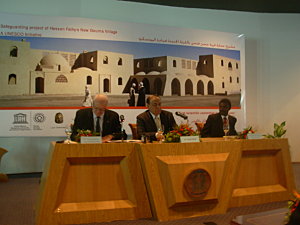There is a point where the UNESCO concept of Intangible Cultural Heritage can get a bit ridiculous– moving from protection of traditions to market branding, and ultimately a cultural competition between nations over who can get more items included on the UNESCO list. That’s what happened to the World Heritage Convention with its yearly beauty contest and winners and losers to be inscribed on the World Heritage list.
But now we have moved on to the Intangible. The Convention itself was visionary in its emphasis of dynamic process over fossilized product (asserting that Intangible Cultural Heritage “transmitted from generation to generation, is constantly recreated by communities and groups in response to their environment, their interaction with nature and their history, and provides them with a sense of identity and continuity, thus promoting respect for cultural diversity and human creativity”). But now it looks like the old ideas of unchanging cultural “icons” and static objects have shouldered aside the process of people making, changing, transforming, adopting, borrowing, and lending that lies at the heart of cultural creativity.
So thanks to yet another failure of UNESCO to go beyond slogans and good intentions, let’s sit back and watch the spectacle of cultural stereotypes being packaged, branded, and declared “authentic” by the experts– while little or nothing is done to protect the distinctive ways of life that created– and still continues to create new forms of Intangible Cultural Heritage.
From The Guardian 27 March 2011:
Italy seeks Unesco protection for Neapolitan pizza
Dish voted by Italians as one that helps sum up nation could be placed on cultural heritage list
Tom Kington in Rome
On a roll after securing Unesco status for the Mediterranean diet, Italy is mulling over an attempt to place the Neapolitan pizza in the pantheon of cultural icons drawn up by the United Nations.
After years of lobbying, Unesco added the Mediterranean diet to its “intangible” cultural heritage list – which recognises festivals, music and crafts alongside its better-known ranking of temples and castles – last year.
Now Italy has put together a shortlist of candidates for consideration in 2011, including pizza from Naples, Sienna’s Palio horse race, violin-making in Cremona, Viareggio’s extravagant carnival procession and ancient festivals in towns such as Nola and Viterbo, where locals carry huge statues on their shoulders and totter round tiny streets.
Also in the running are the small grapevines planted in depressions in the volcanic soil on the island of Pantelleria, where they are sheltered from the fierce sea wind and produce the nectar-like Passito dessert wine.
With only two candidates set to make the final list Italy sends to Unesco for consideration, Corriere della Sera claimed the smart money was on pizza and Cremona’s violin makers, who are fighting off Chinese competition four centuries after Antonio Stradivari opened his workshop there.
But the headlines in Italy have focused on pizza after it was this year voted by Italians as one of the dishes which best sums up their nation. It was narrowly outvoted by pasta with tomato sauce, but beat bruschetta with olive oil into a distant third.
The Unesco shortlist specifies pizza from Naples, where the dish was born in the 1700s, and where a pie topped with mozzarella, tomato and basil leaves – recreating the red, white and green of the Italian flag – was presented to Queen Margherita of Savoy in 1889 and named after her.
Naples’ pizzaioli, the skilled spinners of pizza dough, still insist those three ingredients are all that is required for a perfect pizza and opt for a softer, deeper crust than the thinner, crispier version favoured by Romans.
“A good pizzaiolo leaves the dough to rise for up to 24 hours before baking it in a wood-fired oven to ensure a light, digestible pizza,” the food writer Davide Paolini said.
As the dish edges towards Unesco status, the Italian farmers’ lobby group Coldiretti warned the UN that protection was urgently required.
“Consumers don’t know this, but at least half of all pizzas contain imported ingredients,” it said in a statement, adding that Italians were unwittingly tucking in to Margheritas made with Chinese tomatoes, Tunisian and Spanish olive oil “and even seed oil instead of Italian extra virgin”.




















